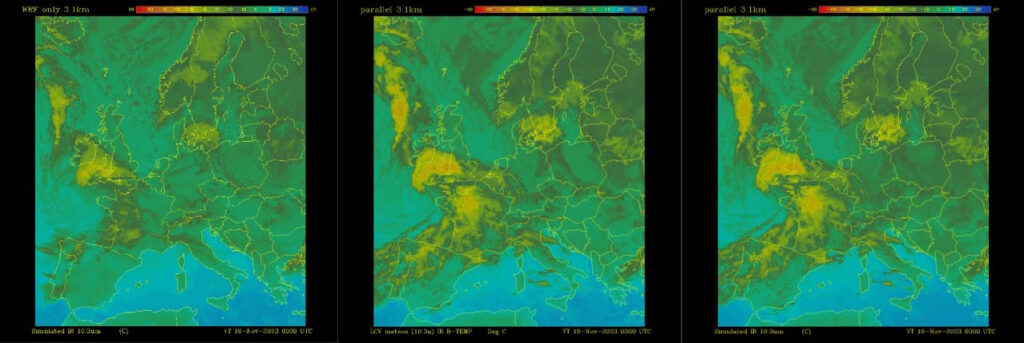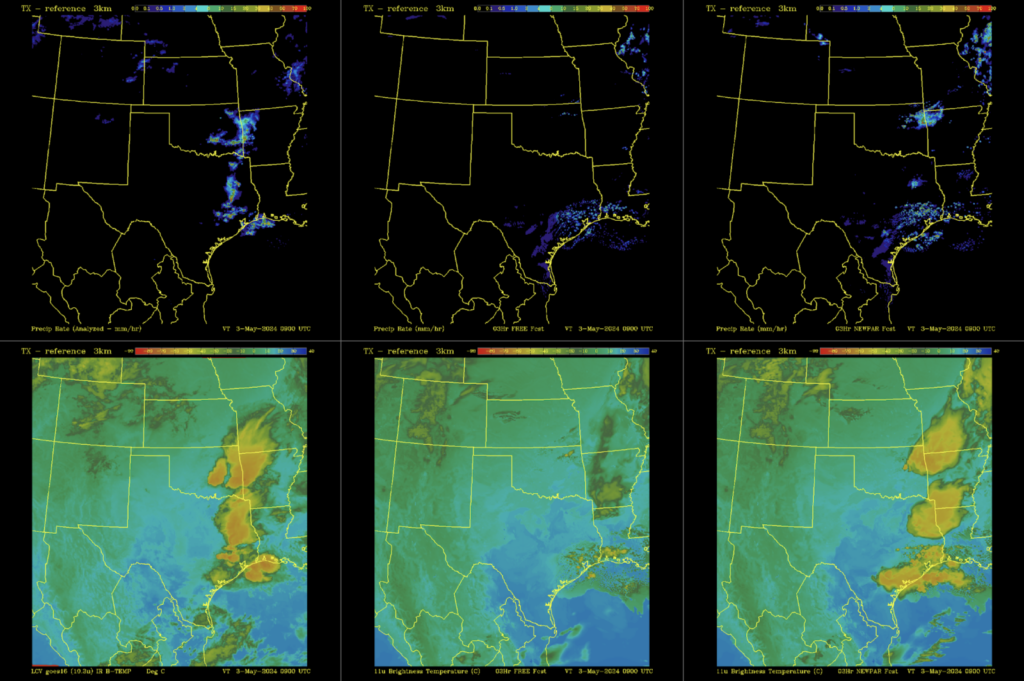Meet the team behind Spire’s innovative cloud analysis and ingestion system enhancing the accuracy of its High-Resolution Forecast
In the fast-evolving world of weather prediction, Spire Weather & Climate has taken a significant leap forward with its recent advancements in High-Resolution Forecasting.
This innovation, driven by cutting-edge in-house cloud analysis and ingestion systems, redefines the accuracy and reliability of short-term weather forecasts. This technology is integrated and available today in our Spire High-Resolution Forecast.
Two key figures behind this breakthrough, Spire Weather & Climate’s Lead Scientist Steve Albers and Numerical Weather Prediction Scientist Gustavo Carrió, delve into the intricacies of this innovation and the journey that brought them to Spire.

Full disk Earth view. On the left, a simulated view from Spire’s analysis is shown for March 21, 2021, at 17:16 UTC. On the right, the observed view for the same date and time is shown, courtesy of DSCOVR.
A journey rooted in cloud analysis: ‘Another level of realism’

Steve Albers’ journey to Spire was shaped by his 32 years of work with NOAA and Colorado State University, where he developed an initial version of cloud analysis.
Prior to that, he earned an M.S. in Atmospheric Science at the University of Oklahoma and a B.S. in Physics at SUNY Albany.
“The cloud analysis has three dimensions,” Albers explained. “It shows all the hydrometeors and some aerosols in the atmosphere. I’ve always been interested in getting clouds into models because that’s one way to drill down into the fine details and see if the model represents reality.”
For Albers, who has been with Spire since 2018, the cloud analysis has always been an “acid test” for models—checking if they can reproduce cloud formations visible in the real world.
This depth of realism goes beyond just breathtaking imagery and “taking the temperature” of the atmosphere; it offers a higher level of accuracy in weather modeling, especially as we move towards higher resolution models that can depict cloud density, type, and precipitation.
At Spire, Albers’ work on cloud analysis has been paired with a complementary cloud ingestion system.

Full disk Earth view. On the left, a simulated view from Spire’s analysis is shown for October 7, 2023, at 00:45 UTC. On the right, the observed view for the same date and time is shown, courtesy of DSCOVR.
The pivotal role of cloud ingestion: Going beyond ‘predictability barriers’

Gustavo Carrió’s career, spanning 16 years at Colorado State University and eight years at Spire, has been focused on simulating cloud behavior over time. His work has involved developing numerical schemes to improve how models simulate cloud evolution.
Carrió, who holds an M.S. and PhD in Atmospheric Science from the University of Buenos Aires, said, “The idea is to determine exactly where the clouds are with global 3D snapshots. That is Steve’s job, and we need to help the model to rapidly and accurately develop what is needed to retain them. It’s not just putting them in; retaining them is a big challenge.”
The cloud ingestion system at Spire plays a critical role in ensuring that models can develop responses consistent with cloud snapshots.
“Models cannot necessarily generate storms exactly where they happen. It is very close to a predictability barrier,” Carrió explained. “But it’s a great help to say, ‘OK, they are exactly here, and they have exactly these shapes,’ and therefore, we go beyond that predictability barrier.”
This complex, multi-dimensional process, which factors in numerous data points simultaneously is a crucial function at the initial stage to ensure that the Spire High-Resolution Forecast responses align with the actual cloud data being ingested.
“The benefit is not restricted to the position of storms,” Carrió added. “There are thinner clouds that cover large areas. Mapping them in a very accurate way improves how the model performs. For instance, low-level temperatures, especially for those very close to the ground, and wind forecasts are more accurate with cloud analysis and ingestion.”
More accurate forecasts of these variables translate to better insights for renewable energy production and other industries reliant on precise predictions.
This capability means the Spire High-Resolution Forecast will better predict evolving weather patterns. This system has been a significant step forward in weather prediction, enabling more accurate, short-term forecasts.

Infrared satellite simulations over Europe on November 16, 2023, at 03:00 UTC. On the left, the WRF model first guess is shown. The middle image shows observed conditions from Meteosat. On the right, Spire’s cloud analysis is shown.
The game-changing impact of hot-start modeling
One of the most groundbreaking aspects of Spire’s High-Resolution Forecast is the hot-start technique, which significantly reduces the model spin-up time.
“Our system is unique because right from the initial time, it almost totally eliminates what we call the model spin-up,” Albers explained. Essentially, the technique provides granular forecast details right away unlike other models, which can take a couple of hours to depict short-term weather forecasts such as convectively driven pop-up thunderstorms.

The top row shows precipitation rates at 06:00 UTC on May 3, 2024. The left image represents observed conditions, the middle shows the Spire High-Resolution Forecast without Cloud Ingestion, and the right displays the forecast with Cloud Ingestion. The bottom row presents infrared satellite brightness temperatures: observed conditions on the left, the six-hour forecast that was initialized at 00:00 UTC without Cloud Ingestion in the middle, and the six-hour forecast that was initialized at 00:00 UTC with Cloud Ingestion on the right.
This capability is a game-changer for short-term weather forecasting, setting Spire apart from other models that take up to six hours to spin-up. Spire’s High-Resolution Forecast delivers critical insights and precise weather details in the short- and medium-range by offering hourly forecasts out to six days at 3 km resolution.
Spire’s in-house cloud ingestion and analysis systems allow us to hot-start our High-Resolution Forecast model, enabling accurate now-casts and short-range forecasts. This provides immense value to clients in energy trading, utilities, and other industries by helping them to maximize efficiency and operations.
Spire’s differentiated data gathered from its fully deployed satellite constellation is coupled with data from government partners, offering comprehensive visible and infrared data.
“That allows us to get more information about how dense the clouds are and how tall they are,” Albers said. “Geosynchronous data is very nice because it’s very high resolution down to about a kilometer or so in the daytime and about 2 kilometers at night. Also, it’s very high temporal, very frequent data.”
The geosynchronous satellite data combined with the Spire High-Resolution Forecast “first guess” and frequent radar data provides another level of precision.
“In theory, we could actually look minute by minute in the forecast model and have a good cloud and precipitation rate forecast,” Albers said.

The Spire High-Resolution Forecast for the continental US for July 30, 2024, is shown without Cloud Radar Data Assimilation on the left. In contrast, the Spire High-Resolution Forecast for the continental US for the same date and time is shown with Cloud Radar Data Assimilation in the middle. Actual radar is shown to the right.
Continuous advancements of our Spire High-Resolution Forecast
Spire’s use of space-derived data, AI, and machine learning further enhances the accuracy of its weather predictions.
Carrió noted that aerosols are another area of focus. These particles, such as dust and smoke, can significantly affect visibility and solar radiation, making their accurate modeling essential for reliable forecasts critical to industries such as energy.
“Features like pollution change the ways clouds behave and how radiation heats differentially with altitude, and therefore also condition how clouds will evolve due to the availability of energy and so on,” Carrió explained.
Looking ahead, both Albers and Carrió are excited about the potential to enhance Spire’s weather prediction capabilities. They’re particularly interested in improving the way models interact with environmental factors like pollution, which can influence cloud behavior and weather patterns.
“I’m continually impressed by the breadth and depth of expertise across our scientists, like Steve and Gustavo, at Spire Weather and Climate. This knowledge enables us to build unique, differentiated systems that extend well beyond simply processing public data,” Dr. Tom Gowan, Spire Director of Weather Prediction and AI, said. “By developing proprietary tools in-house, such as our cloud analysis and ingestion system, we can deliver more accurate and tailored forecasts, offering a significant advantage to our customers in the energy, commodities, and utilities markets.”
As Albers and Carrió, along with other scientists on the Spire Weather & Climate team continue to refine and expand these capabilities, the future of weather forecasting looks brighter—and more accurate—than ever before.
Spire Weather & Climate’s advancements in cloud analysis and ingestion mark a new era in high-resolution weather prediction
Explore our Spire High-Resolution Forecast
Learn more about AI weather forecasting at Spire
 Written by
Written by


